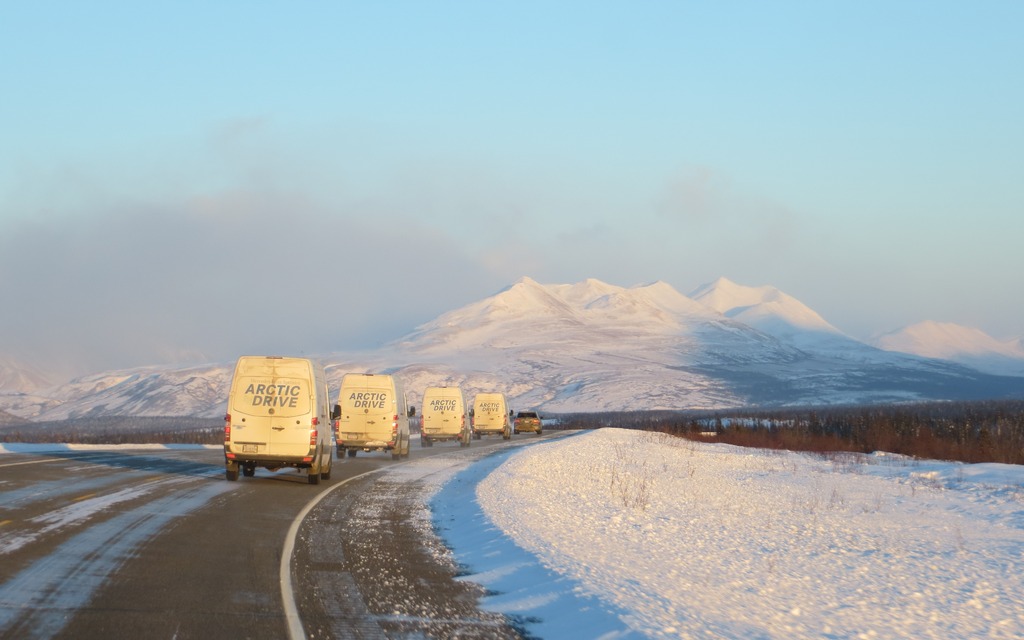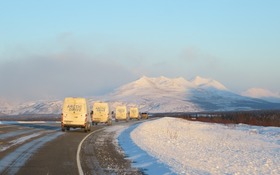Mercedes-Benz Sprinter Arctic Drive Diary - Day One
It's early on a Monday morning and I'm sitting in a conference room at a hotel listening to a PowerPoint presentation on the Mercedes-Benz Sprinter van - you know, the German brand's full-size cargo and passenger option that has been plying North American roads for the past several years. Pretty standard fare for an automotive journalist, really, except for the fact that this particular hotel is located in Anchorage, Alaska, and I am just minutes away from the start of a journey that will send me 1000 kilometres away from this room, all the way past the Arctic Circle, until I am standing under the center band of the aurora borealis.
Mercedes-Benz has invited a small group of automotive media members to take part in this Alaska adventure in order to demonstrate how the Sprinter van fleet performs in the extreme conditions that are predicted for the arduous journey northward. It's been explained that temperatures reaching -50 degrees C, blowing snow, and the treacherous condition of the Dalton Highway - one of the most infamous stretches of road in the world - could all be encountered during the course of the next four days of driving. If ever there was a torture test for a van, the Mercedes-Benz Sprinter Arctic Drive is it.
- Also: Mercedes-Benz Sprinter Arctic Drive Diary - Day Two
- Also: Mercedes-Benz Sprinter Arctic Drive Diary - Days Three and Four
A Rugged Chariot For Winter Adventure
The ten-van convoy that will make the trek northward consists of a mix of 2500-series Mercedes-Benz Sprinters from both the cargo and passenger branches of the family tree. The majority of the vehicles fall into the former category, with the van I have been assigned to featuring a 144-inch wheelbase and a huge, open area separated from the cab by a glass-and-steel panel. A pair of three-row passenger models and several 170-inch wheelbase cargoes are also along for the ride, with a Mercedes-Benz M-Class SUV riding point and a GL-Class bringing up the rear.
Mercedes-Benz is optimistic about the Sprinter's capabilities in the Alaska wilderness, but there remain some key question marks regarding the vehicle's ability to deal with the day-to-day rigors of cold weather driving. Of chief concern is the Sprinter's power plant, a 3.0-liter, 188 horsepower turbodiesel V-6. Also capable of generating 325 lb-ft of torque, this unit is matched up with a five-speed automatic transmission and features a fuel efficiency rating of 9.4 l/100 km on the highway.
Diesel engines are notoriously fussy about starting in the dead of winter, as their spark-less design makes it that much harder to achieve ignition when the mercury drops. Compounding things further is the fact that the tranny, motor, and electronic stability control system of the Sprinter have only been cold weather tested to -30 degrees C, which is roughly 20 degrees C warmer than the ambient temperatures predicted along our route to the Arctic. To help head off any potential issues, the vans we are driving have been outfitted with a heated fuel filter, heated BlueTEC emissions system, and auxiliary heaters for both the engine and the cargo and passenger compartments, as well as a 'pre-heat' function that allows for the vehicle's coolant to be warmed up roughly 30-minutes prior to being started.
The Road To Fairbanks
It's roughly 10 am before we get underway this morning, and riding shotgun beside me is Paul 'Willy' Williamson, a Winnipeg-based writer who will be my companion for the next five days. Our initial route is snowy but smooth, although the Alaska sun has only barely peaked over the horizon by the time we leave Anchorage behind us and hit the highway. There are only six-and-a-half 'potential' hours of daylight available to us this week, due to our polar position and the tilting on the Earth, and much of our journey will be accomplished in darkness.
Located smack dab in the middle of the map between Anchorage and Fairbanks, our first checkpoint, is Denali National Park and Reserve, home to the tallest peak in North America, the inexplicably-named Mt. McKinley. The amazingly clear, post-sunrise blue sky we were treated to by noontime gave us an incredible vantage point from which to view the snow-covered peaks that dominate the landscape of the Glenn Highway. We were lucky to have avoided the blowing snow that can completely obscure even the tallest of the mountains in Denali, and we stopped several times to snap photos of nature's splendour.
After an 'interesting' truck-stop lunch, we move deeper into Denali and edge closer to Fairbanks, which has a population of just over 50,000. So far, the Mercedes-Benz Sprinter has performed admirably, although temperatures approaching -40 degrees C have forced us to keep that auxiliary heating system roaring in an effort to stay toasty inside the van's cab. Venturing outside of the vehicle even for short periods can easily freeze up fingers, toes, and noses, and so we are grateful for the diesel-generated heat that the Mercedes-Benz can provide.
After more than 600 kilometres of driving, split between Williamson and myself on snow-covered uphill and downhill roads, we pull into Fairbanks at the end of the first day surrounded by the complete darkness of the early Alaskan night. Our vans huddle together in the parking lot of Pike's Landing, our accommodations for the night, with their engine heating systems programmed to come online at seven a.m. the next morning for an early start on the most challenging section of our drive north. Myself and the other drivers retire to our respective rooms, exhausted from the day's labours and hopeful of catching a few hours of sleep to keep us alert for push towards the Arctic Circle.












